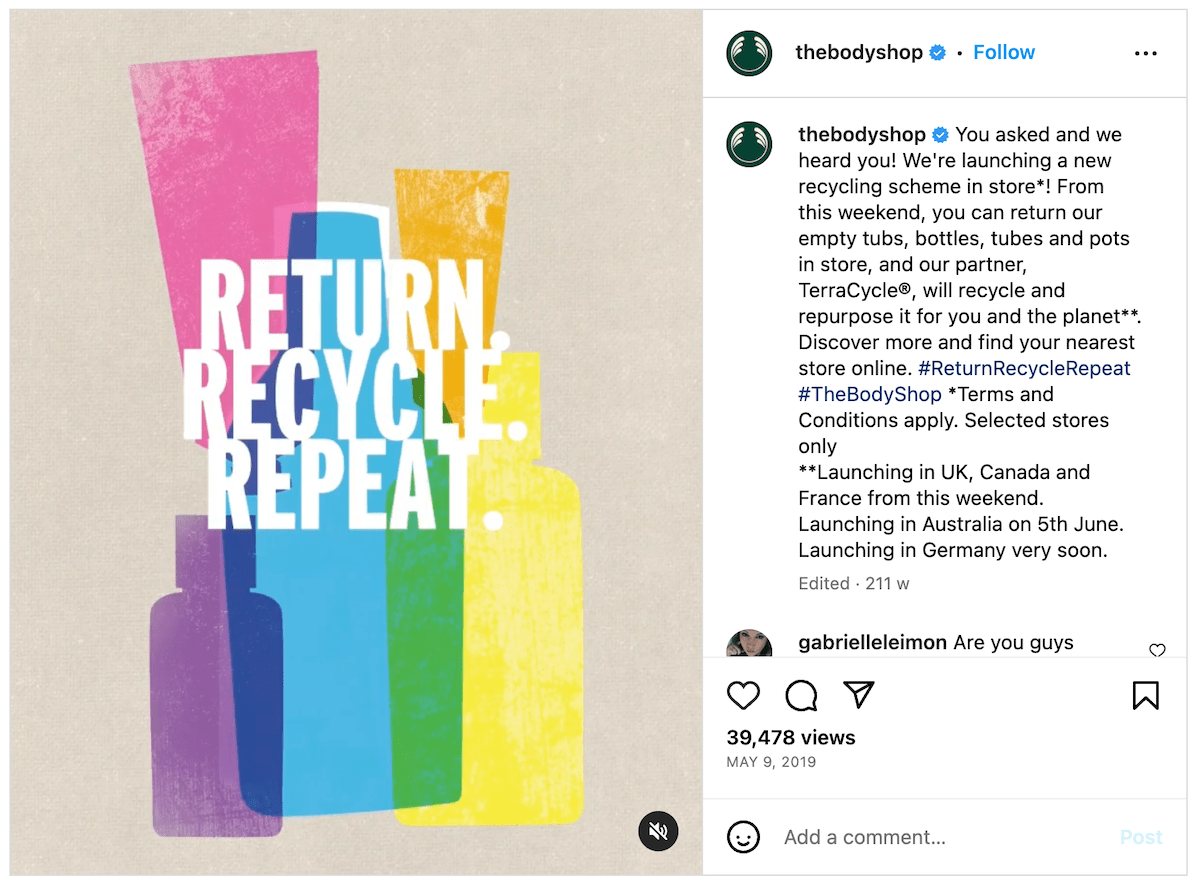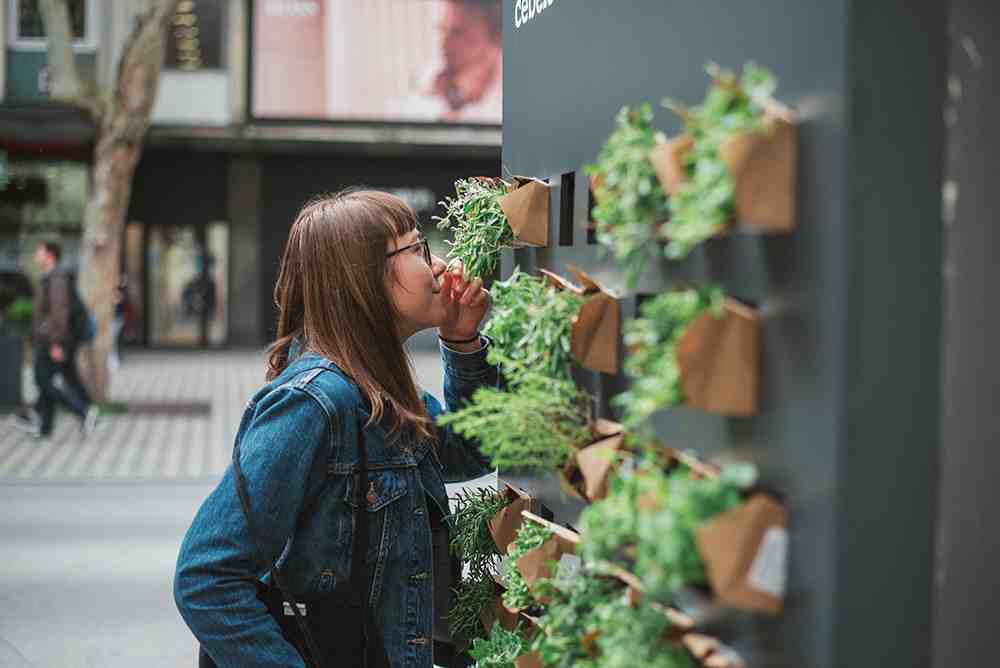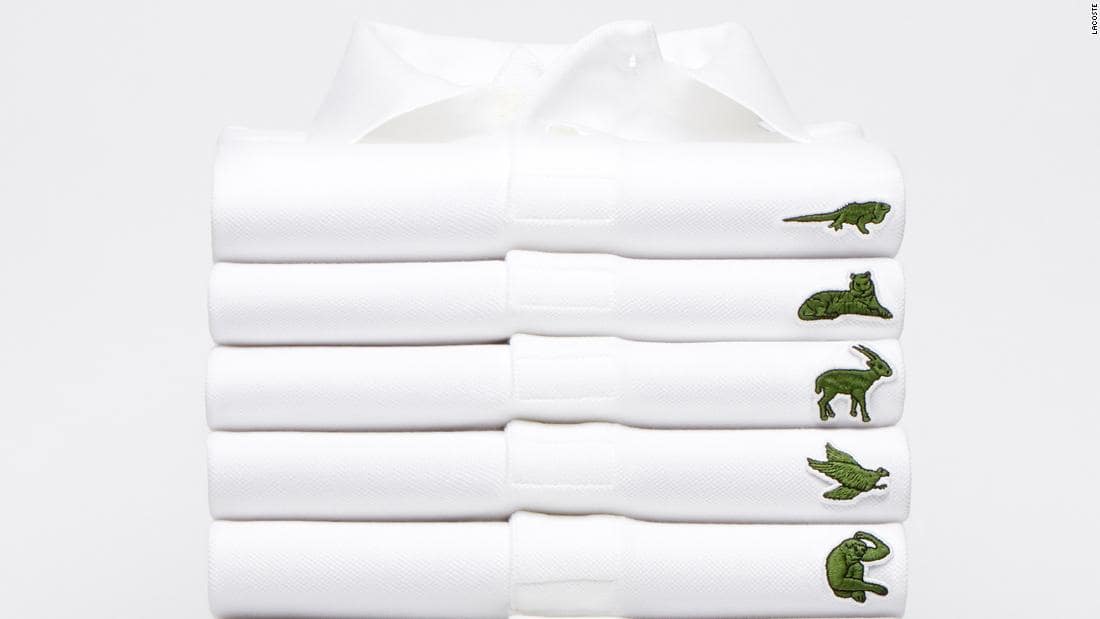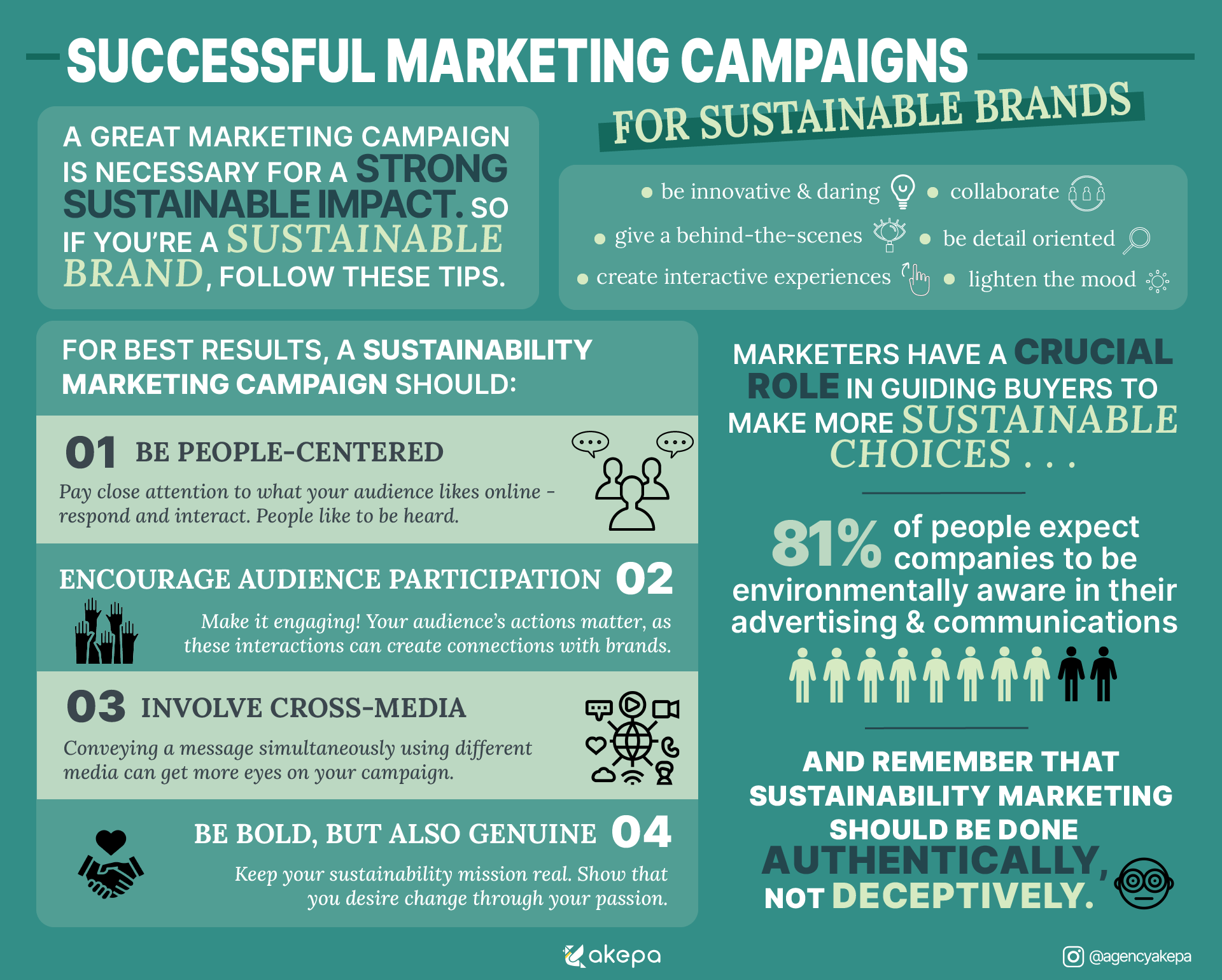While some of us go the extra mile to reduce our impact on the planet, we cannot do it alone. We need brands, who have much more influence than a single person, to take transformative action.
Companies from all sectors have promised to reduce their footprints in an effort to increase their brand sustainability for the good of the planet. But to do that, brands have to get their message across to a wide audience in a memorable way. After all, brands can’t do it alone either.
To make the most powerful sustainable impacts, it’s one thing to have a great idea. But it’s another to tactfully attract people to it. This article showcases 4 sustainability marketing examples that remain etched in people’s minds.
Let’s dive in.
1. Return, reuse, and repeat
- Brand: The Body Shop
- Campaign: #BringBackOurBottles
- Marketing strategy: Customer marketing
The Body Shop is one of those rare brands that realize the beauty industry is in dire need of a makeover. This sector alone generates billions of plastic pieces each year that end up in landfills and the ocean. While The Body Shop is not exempt from contributing to this issue as they still use some virgin plastic, we believe their heads are in the right place.
And so the #BringBackOurBottles campaign was born.
The beauty giant created its own hashtag, which started in Indonesia, to encourage customers to do just that — return the empties.

The innovative brand partnered with TerraCycle to install product recycling bins in store locations worldwide — an ongoing program that motivates customers to return their empties in exchange for a redeemable discount voucher.
Clever!
FYI: This puts The Body Shop in the spotlight as an active promoter of the circular economy.
The strategy behind it all?
The Body Shop uses various marketing strategies (as do most brands) but customer marketing is the driving force behind creating awareness. It’s about maximizing strong customer relationships and community surrounding a brand. This form of marketing improves customer’s experiences, strengthening the brand’s retention and growth. Meaning, people will likely do the marketing for the company if they love the brand.
To make customers connect with The Body Shop more, the company listened to the needs of its customers. They asked how they can recycle their empties and The Body Shop offered the perfect solution. In turn, customers feel satisfied they can still support a brand they like while being just as supportive to the environment.
And despite recycling not being the solution to the plastic problem, it’s nevertheless a positive step and hopefully it’ll help The Body Shop transition into using 100% post-consumer recycled plastic only.
Why did it work?
Due to the volatile nature of the modern market, many businesses can testify that attracting new customers is like tracing the last haunts of the slender-billed curlew (an endangered bird no longer frequenting the Danube delta) — it can be a costly, time-consuming, and disappointing exercise.
Retaining customers is cheaper than discovering new ones. Plus, brands that use customer marketing can often expect consistent and predictable income. The aim is to turn existing customers into advocates.
Customer marketing works for The Body Shop because the majority of its customers prefer supporting brands that take social and environmental issues seriously. More people want to participate in the effort to make the planet less trashy and they will likely make waves about it online.
Despite The Body Shop’s large scale success, it continues to focus on the human aspect of its customer relationship journey to establish confidence. After all, trust in a brand is what makes people feel empowered to share their stories.
2. Feeding bees in autumn
- Brand: A1 Telekom
- Campaign: Urban Bee Oasis
- Marketing strategy: Traditional and social media marketing
A1 Telekom Slovenia created quite a buzz with its one-week Urban Bee Oasis Campaign.
In the build-up to World Bee Day in 2018, the campaign aimed to draw attention to the impact of global warming on flowering time in urban landscapes. This has a ripple effect as the depletion of food supplies dwindling in late summer causes bees to starve.
And when the bees go hungry, people go hungry.
Video Attribution: Bee Movie, NBC Universal
The strategy behind it all?
To raise awareness and help city-dwelling bees, A1 Telekom produced an urban garden in the heart of Slovenia. The telecommunications company combined out-of-home (OOH) advertising, a traditional marketing strategy, with social media marketing to build hype.

Over the course of a week, 3,500 honey bee plants were grown and visitors were encouraged to adopt one of 12 plants to create their own bee forage oasis at home. As a result of the collective effort, bees could survive through autumn.
This sustainable marketing campaign resonated on social media with a reach of over 350,000 users. The digital marketing efforts created 3,500 interactions and received 88,330 video views. This success is proof that a brand in any sector can effectively drive powerful audience engagement when it spreads a sustainable message.
Why did it work?
Traditional marketing often compliments digital marketing in that people are more likely to notice or click on an online ad after seeing an OOH advertisement. In this case, the OOH ads (the bee gardens) created a lasting impact on locals and the physical exposure supported the company’s social media marketing efforts.
But Slovenia is not a random location of choice.
Not only is Slovenia one of the first EU countries to prohibit the use of pesticides specifically harmful to bees, but it’s also known as a nation of beekeepers. Yes, honey and hives are practically a religion in one of the world’s most environmentally-friendly nations.
It is therefore not surprising that A1 Telekom’s Urban Garden Oasis Campaign was the bee’s knees.
3. The disappearance of the crocodile
- Brand: Lacoste
- Campaign: Save Our Species Campaign
- Marketing strategy: Cause marketing
The global apparel brand, Lacoste, made a snappy decision to support species conservation action worldwide. In a three-year collaboration with International Union for Conservation of Nature (IUCN)’s Save Our Species initiative, the brand launched limited-edition polo shirts. The company’s winning idea was to boldly replace its iconic crocodile embroidered logo with 10 threatened species and match the number of shirts with the number of individuals left in the wild.
The 10 threatened species included: The Vaquita (Phocoena sinus), Burmese Roofed Turtle (Batagur trivittata), Northern Sportive Lemur (Lepilemur septentrionalis), Javan Rhino (Rhinoceros sondaicus), Cao-vit Gibbon (Nomascus nasutus), Kakapo (Strigops habroptila), California Condor (Gymnogyps californianus), Saola (Pseudoryx nghetinhensis), Sumatran Tiger (Panthera tigris sumatrae), and the Anegada Ground Iguana (Cyclura pinguis).
But wait, there’s more.
Lacoste also donated the proceeds directly to the preservation of each of the above species.
The strategy behind it all?
This clever sustainability marketing example is known as cause marketing, which is a pivotal part of brand strategy nowadays.
Not only did the initiative position Lacoste as an active participant in wildlife conservation, but the campaign also won two golds in the Clio Fashion & Beauty awards — in Partnerships & Collaborations and Public Relations.
Why did it work?
Seeing as the crocodile is one of the top famous logos in the world, it acted as a megaphone to draw public attention to the campaign.
Considering how difficult it can be to survive the scrutiny of customers and the fact that the renowned brand removed its logo entirely (even temporarily), showed Lacoste’s level of dedication to raise awareness.
The company’s strong commitment is exactly why the idea won.
Even though the number of polos for each species were different, all of the shirts sold out in 24 hours with a 76% increase in new clients, 600k shares, and 1.2 million impressions on social media. What’s more, the IUCN gained 4 times more donations, traffic to saveourspecies.org increased by 200%, and newsletter subscriptions increased by 300% during the operations.
But never mind the overnight sell out, this brilliant sustainable marketing campaign was in the media across the globe — even in countries where the shirts were not available for purchase.
Now, that’s a happy ending.
Well, almost. There is an edgier epilogue. Despite the clear commitment shown towards species conversation in this campaign, Lacoste is classified as having one of the lowest scores on Good on You – the world’s leading app for fashion brand sustainability ratings.
4. Plastic fishing
- Brand: Corona
- Campaign: Plastic Fishing Tournament
- Marketing strategy: BTL + cause marketing
Some people raised doubts about Corona’s ability to perform when the last pandemic went global three years ago. In spite of the name association, Corona managed to keep the number one position as the world’s most valuable beer label in 2020, showing the power of brand resiliency. Shortly after, they used this very same power for good.
Known for its long-standing stance against plastic pollution, Corona launched the Plastic Fishing Tournament as an international campaign to strengthen its commitment to the environment. The beer brand sponsored the event, which rewarded anglers for fishing plastic waste out of the sea.
Catch plastic, make money, and clean up the ocean.
Within several hours, 80 fishermen removed over 3 tonnes of plastic from the Pacific Ocean.
The strategy behind it all?
To create this successful event, a combination of below-the-line (BTL) and cause marketing strategies were used to drive awareness and brand consistency.
Together with creative agency WeBelievers, Corona held the competition as part of an initiative to clean up and save the world’s oceans.
In the summer of 2021, the pilot took place in Mazatlán, Mexico. Although the top winner was paid 14,800 pesos (the equivalent of one month’s wages), no one went home empty-handed. Corona connected participants with the country’s largest recycling company México Recicla to compensate everyone with higher-than-average rates – compared to fishing – for their hauls. Fishermen were also given vouchers for fishing supplies and cleaning tools made from recycled materials. Post-event, México Recicla was in charge of upcycling the recycled plastic into tools for fishermen.
Since then, Corona has brought the Plastic Fishing Tournament to South Africa, with rollouts in the works for even more countries.
The campaign has won numerous awards, including three Grand Clios and Cannes Lions Creative Marketer of the Year 2022.
Why did it work?
Events – a type of BTL marketing – are a great way to generate PR buzz, establish presence, and connect with specific audiences. But, they can often appear as one-time stunts and mean little in the long run if they don’t support something greater.
Prior to 2021, Corona had already spent years on its mission to end marine plastic pollution. A month before the tournament, Corona became the first company in the beverage industry to achieve a net-zero plastic footprint. At the same time, they started the Protect Our Beaches initiative with non-profit organisation Oceanic Global.
As part of their overall marketing strategy, Corona has long used beach imagery in campaigns., That in mind, it only makes sense that they continue to focus on environmentalism to further promote the brand.
This goes to show that while sustainability marketing can have a great impact, we should also consider a brand’s overall actions (and intentions) before choosing to support solely based on a campaign. If we don’t, we could fall victim to greenwashing.
Cleverness is one thing. Authenticity is another.
To sum it all up…
If you are interested in telling your sustainability story in an impactful and genuine way with the help of a sustainable digital marketing agency, contact us!





It is really good example of sustainable marketing campaign. Authenticity is more important for lasting long. Clever is OK but we should avoid cunning.
Exploring sustainability marketing campaigns and their impactful examples! 🌱💡 Great insights for businesses looking to make a positive environmental impact.
Thanks for your comment. I’m glad these examples resonated with you.